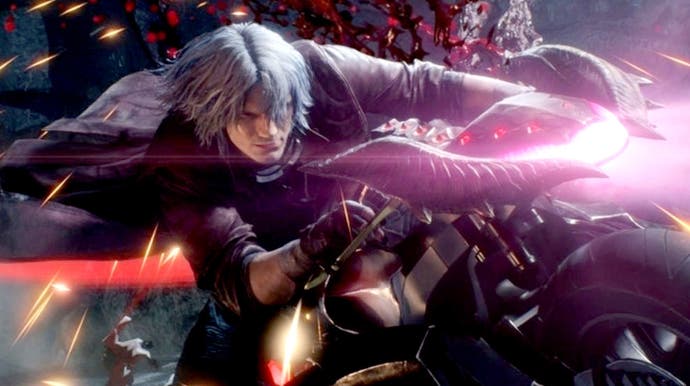Devil May Cry 5: Special Edition - the first PS5 vs Xbox Series X platform comparison
Which machine is faster? It's complicated.
It's finally happening. Ever since Microsoft and Sony revealed the hardware specifications of Xbox Series X and PlayStation 5, the question has always been to what extent differences in teraflops, clock speeds and memory bandwidth will actually translate into the gameplay experience and today, we have our first glimpse at how the systems truly compare. Capcom's Devil May Cry 5: Special Edition was initially supplied to us on PlayStation 5 last week, with Xbox Series X code arriving yesterday. There's what looks very much like feature parity across the board here, and a unique set-up that's very friendly for benchmarking - so which machine is faster?
First of all, it's worth emphasising just how preliminary this test is. Devil May Cry 5: Special Edition is essentially a cross-gen title - an enhanced version of the game already available on current generation Xbox and PlayStation hardware. And we also know from developer conversations just how hard it's been to get final software ready for launch, especially on the Xbox side, where several studios have had challenges in moving across to the development environment. With that said, however, Capcom previously stated that Xbox Series X would not ship with ray tracing support, which would be PlayStation 5 only - but the truth is that both consoles arrive with the exact same features across the board, RT included.
However, DMC5 is in many ways an excellent test for performance. First of all, the game features several rendering modes - all of which appear to be identical between the two systems. The fact that they are so similar means that Capcom felt confident enough in the specs of both systems that they did not feel that they had to reduce resolution on one or the other. Secondly, we have several rendering modes available - a standard 'normal' native 4K option, ray traced quality and performance modes, plus a high frame-rate mode aimed at 120Hz gaming. On top of that, when run on a 120Hz screen, all modes operate with an unlocked frame-rate, meaning that every game variation has the potential to break the 60fps barrier. In short, this is as close to a benchmark as you're going to get.
Let's talk about each of the modes in turn: what they promise in features and what they deliver in performance on each system? But before we proceed, we have one caveat to share. Currently there are no capture devices that support full 4K capture at 120fps, so our video is limited to 1080p. In terms of confirming pixel counts, we had to use system software screenshots because of that limitation, which limits the scope of the sample we could actually test. With that said, dynamic resolution does not seem to be in the mix. If we discover any variances, we'll be sure to pass that on. The frame-rate though? That's a lock for launch day code.
Normal Mode: The standard way to play Devil May Cry on both PlayStation 5 and Xbox Series X systems is to use the normal mode, which operates with native resolution rendering at full HD - 3840x2160. It's an impressive boost over PS4 Pro, which used image reconstruction techniques to hit 1800p, with Xbox One X also using reconstruction to target 4K. Gameplay on the new systems is mostly at 60fps or higher, but there can be drops below - and cutscenes are especially impacted. In normal mode, Xbox Series X is consistently faster than PlayStation 5 but only in single digit percentage terms - around eight per cent.
High Frame-Rate Mode: This mode retains a 3840x2160 target resolution, but achieves it using image reconstruction techniques - effectively smart upscaling from a smaller native resolution. In fairness, Capcom's solution here is excellent and the increase to frame-rate is substantial. Across a range of content tested in this mode, both consoles delivered a 100fps average. However, the average does not tell the real story. Xbox retains an advantage in cutscenes and in some gameplay content, but again, the boost is typically small. Meanwhile, in many of the gameplay areas we tested, PS5 is significantly faster and more consistent that Series X overall. It's conjecture on our part, but there is the sense that there's a graphics API bottleneck here that impacts performance on the Xbox side in some scenarios, while PS5 simply powers on.
Ray Tracing Performance Mode: This runs at native 1080p on both platforms, with full ray traced reflections plus frustrum-aligned voxel fog, which transforms the lighting. Broadly speaking, dropping resolution allows RT to run at similar frame-rates to the normal mode, albeit with a big resolution penalty. In matched like-for-like content such as cutscenes, Xbox Series X enjoys a very small performance advantage - but this seems to be even lower than it was in the normal mode. And again, perhaps it's down to the dynamic nature of gameplay where like-for-like, pixel-for-pixel matched content is not possible, but there do seem to be some areas where PlayStation 5 enjoys its own tiny lead. The overall takeaway here is that both systems are essentially like-for-like.
Ray Tracing Quality Mode: This ramps resolution back up to 3840x2160, but it's using the same image reconstruction technique used in the high frame-rate mode in order to boost performance. The impact of RT is pretty large, however, and much of the experience plays out beneath 60 frames per second. On paper, Xbox has a lead - but it is vanishingly small - and in matched like-for-like content, PS5 actually manages to match Xbox performance for much of the duration, while in other scenes it's just 2-3fps behind. However, while difficult to pinpoint exactly owing to the lack of exact like-for-like gameplay, Xbox's gameplay performance advantage seems to open up here.
Ultimately, this is just one game from one developer, using an upgraded version of an existing engine and while it's difficult to tell, it does seem as if the more forward-looking features of RDNA 2 such as variable rate shading are not being used. With that said, based on the software we have in front of us, the overall outlook is that the experience between both systems is broadly equivalent in pure performance terms. Xbox seems to have a consistent - if very small - advantage in three of the four modes, while its inconsistency in the high frame-rate mode is puzzling to say the least.
However, the fact that we can use Devil May Cry 5 as a 'benchmark' at all is mostly down to the fact that the developers have targeted 120Hz as the standard refresh rate output. This is great for seeing top-end performance metrics, but it's bad news for the experience - especially on PlayStation 5. This is because 120Hz output is locked to any screen that supports 120Hz, no matter the resolution. So consider a highly popular 4K screen - the LG OLED B8. PS5 sees that it is 120Hz-compatible, and overrides 4K resolution. All modes will run at a 120Hz refresh rate, at 1080p resolution - which is absolutely not ideal. Another popular screen is the Samsung NU8000. It's a 4K screen but on PS5, Devil May Cry will force through the 120Hz refresh rate instead, resulting in a downscale to 1440p that the user has no control over.
And this is where Xbox Series X has an advantage that's crucial. Users can simply dip into the video settings, select 60Hz and Devil May Cry 5 runs in a generally stable way - a locked 60 frames per second is very much preferable to the fully unlocked set-up on a 120Hz screen whether you're gaming on PS5 or Xbox Series X. We have shared our findings with Capcom a while back, and fingers crossed there'll be a solution to the issue, but the tl;dr version is simple enough on paper: allow PS5 users to select between 60Hz and 120Hz output resolution.
In the meantime, the results seen here in the cross-platform comparison are fascinating. In terms of correlating on-paper specs to the actual experience on-screen, PlayStation 5 is either punching above its weight, or Xbox Series X isn't delivering on the full potential promised by a bigger silicon investment and a much more substantial memory interface. It'll be interesting to see to what extent the results seen here extend to other titles, and we'll be reporting on that as soon as other games are available.












